Understanding Parakeet Flight Cages: A Guide for Enthusiasts
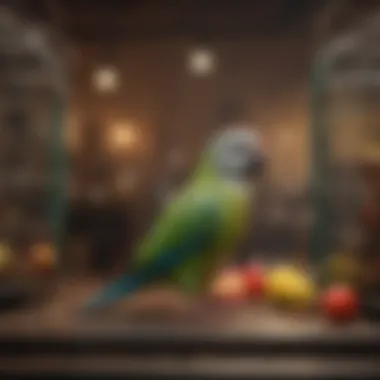
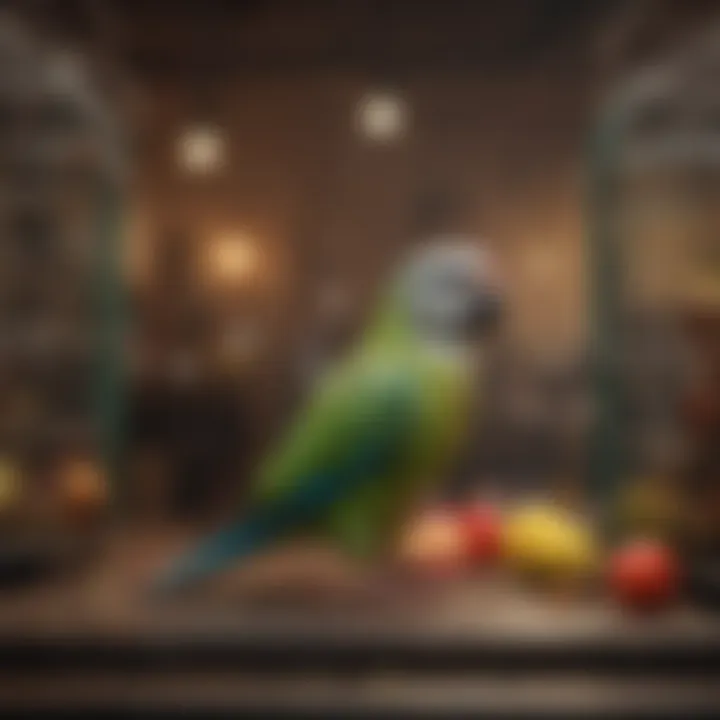
Intro
The significance of selecting the right flight cage cannot be overstated for parakeet owners. These birds possess a natural inclination to move, explore, and glide. Hence, adequate space and the right environment become paramount for their overall health and contentment. In this guide, we will explore pertinent aspects regarding parakeet flight cages. This will include how to choose, manage, and optimize cage features along with following best practices for setup. Whether you are a newcomer to avian care or possess extensive experience, this comprehensive resource aims to address your needs and concerns.
Care Tips
Caring for your parakeet involves several essential routines that ensure a happy and healthy living space. For bird owners, understanding various elements of cage care goes a long way to fostering a good environment.
Daily Care Routines
Establishing a strict yet adaptable daily routine is crucial. This routine should include:
- Offering fresh water and food every morning.
- Ensuring seeds and other perishables are replaced daily.
- Spending time with your birds to maintain social interaction.
Cage Setup and Maintenance
Setup starts with ensuring the cage size is adequate. Parakeets need space to fly within the cage. Minimum recommended dimension should be at least 30 inches long, 18 inches wide, and 18 inches high for a pair. Important features to consider:
- Positioning: Avoid direct sunlight and drafts.
- Perches: Vary in shape and diameter to promote foot health.
Hygiene and Cleaning Practices
Hygiene is critical for bird health. Waste can accumulate, leading to health risks if not addressed. Follow these cleaning practices:
- Clean food and water dishes daily.
- Inspect perches and remove soiled materials weekly.
- Conduct deep cage cleaning on a monthly basis with a mild, bird-safe disinfectant.
Seasonal Care Adjustments
Be observant during seasonal transitions. In colder months, ensure ample warmth with appropriate insulation or heated elements. In the summer, ensure proper ventilation is in place. Also, modify the diet according to seasonal needs, using fresh herbs and veggies when available.
Behavioral Insights
Understanding specific avian behavioral cues significantly enriches your bond with your pets. Parakeets communicate through body language and vocalizations. For instance, a puffed-up appearance can illustrate discomfort. Conversely, an active and curious bird may enjoy their environment.
Common Behavioral Issues and Solutions
Common issues may emerge including feather picking and excessive squawking. Feather plucking may be treats with the incorporating appropriate toys and enriched stimuli such as varied perches or interactive structures. On the other hand, excessive noise can be minimized through proper social interaction or engaging activities.
Positive Reinforcement Techniques
Using positive reinforcement during training can encourage desired behavior. Reward treats and praise for following commands. This builds trust and affirms your relationship with your avian friend, making both parties comfortable and engaged.
Social Interaction Needs
Socializing your parakeet cannot be overlooked. These birds are inherently social and often thrive with companion interactions. Aim to spend quality time chatting with them or alternate between letting them play with another bird within the appropriate environments, ensuring harmony.
Nutrition Guides
Nutrition profoundly affects overall well-being. Establish a wholesome diet for lasting health.
Essential Diet Components
A balanced food mix is fundamental. Offer high-quality seed mixes while supplementing with fresh vegetables, fruits, and grains. This instills a varied diet that closely mimics their natural feeding patterns.
Safe and Toxic Foods
Being aware of foods that are harmful is equally important:
Safe Foods:
- Leafy greens like kale and spinach
- Melons and bananas
Toxic Foods:
- Avocados
- Onions
Supplements and Treats
Additionally, provide minerals through cuttlebones or mineral blocks. These are eletent for sustaining beak and feather health. You may consider bird-specific treats for training or special rewards.
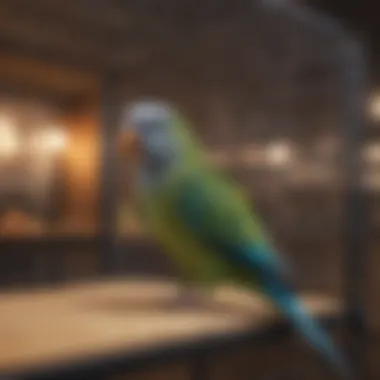
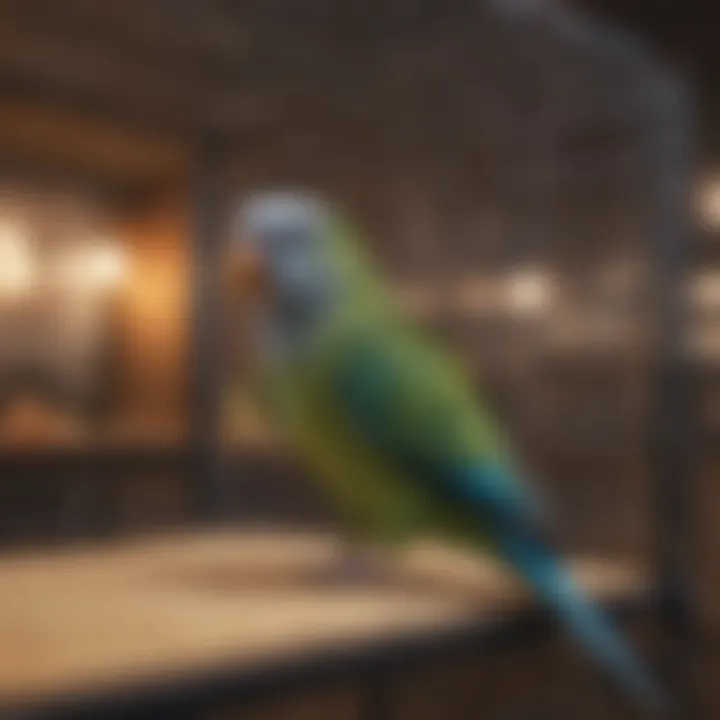
Feeding Strategies for Different Species
Different parakeet species may exhibit varying incomingenes and feeding patterns. Be cognizant of their requests during feeding. Research into their breed to optimize their unique dietary options.
Wellness and Health
Maintaining well-being should be prioritized for your pets' long-term happiness and vitality.
Routine Health Checkups
Regular vet checkups are essential for monitoring avian health. Foster a relationship with an avian vet experienced in bird care.
Identifying Symptoms of Illness
Look for the following signs, which may indicate health issues:
- Changes in eating habits
- Decreased activity
- Discoloration or abnormal droppings
Preventative Care and Vaccinations
Before acquiring a pet bird, inquire about necessary vaccinations. Stay informed regarding parasite prevention throughout their life to avoid subsequent illnesses.
Mental and Emotional Well-being
Emotional health matters as much as physical health. Encourage time outside the cage as well as interactive toys assignments. Create an enriching, stimulating environment through variances.
Enriching Activities
Engagement through activities promotes healthy dynamics. Offering varied stimulation keeps your parakeet awe and affirms excited living.
Toys and Playtime Ideas
Introduce different types of toys. Consider options such as swings, ladders, and chewing toys to keep them both entertained and physically active.
Training and Tricks
Training can be fulfilling for both pets and owners. Start with easy commands like
Preface to Parakeet Flight Cages
Parakeet flight cages are crucial in ensuring the health and well-being of pet birds. Choosing the right flying environment can greatly impact parakeets' physical health and mental state. \n\nUnderstanding the elements of parakeet flight cages is essential for passionate bird owners. These cages differ significantly from traditional birdcages, offering more space for exercise and stimulating natural flying behavior. Commanding attention through their vibrant colors and chirps, parakeets enjoy the freedom to stretch their wings and explore their surroundings. Thus, investing time into selection is worth it.
Definition and Purpose
A flight cage is a larger, more spacious enclosure designed for birds. Unlike more confined cages, these structs allow avian inhabitants ample room to move about. Most typically constructed from sturdy materials, flight cages are engineered for both security and comfort.
The primary purpose behind a flight cage is to facilitate the bird’s natural inclinations to fly and exercise. It's understood that in nature, birds engage in various flight patterns. Flight cages seek to mimic this aspect of their environment, helping maintain physical fitness and happiness in pet birds. When selecting a flight cage, understanding its definition and purpose allows bird owners to appreciate its value.
Benefits of Flight Cages for Parakeets
The benefits of flight cages offer significant advantages over traditional cages, effectively enhancing quality of life.
- Increased Exercise: Heightened room translates directly into improved flying capabilities. This engagement mitigates issues like obesity and muscle atrophy often seen in more confined spaces.
- Reduced Boredom: A larger space allows for better enrichment, such as toys and perches, preventing the monotony orchestrated by constrained environments. This reduction in boredom can mitigate aggression or anxiety within the flock.
- Enhanced Social Interaction: Bigger cages can often house more than one parakeet. Trained interactions among multiple birds can usher in more socially balanced pets.
Ultimately, a suitable flight cage can act as a boundary where freedom meets security, creating the ideal ecosystem for your asscociated avian companion.
Ensuring proper assessment of flight cages contributes considerably toward their long-term happiness and health. Continuous consideration of the environment caged-inside and outside forms the basis for the thoughtful participating bird owner.
Types of Flight Cages Suitable for Parakeets
Choosing the right flight cage for parakeets is crucial in fostering their health and happiness. Parakeets are vibrant creatures that need enough space for flying, exploring, and playing. Options for flight cages vary based on size, purpose, and location, underscoring the diversity that fits different preferences and environments. An appropriate flight cage improves not only the well-being of the birds but also the satisfaction of the owners in providing a nurturing habitat. Therefore, understanding the nuances of different flight cage types remains essential for all avian enthusiasts.
Indoor Flight Cages
Indoor flight cages provide a practical solution for bird enthusiasts living in apartments or homes with limited outdoor access. These cages are often designed to balance space efficiency and functionality. Indoor cages typically have a spacious design that allows parakeets to stretch and flap their wings freely, essential for their fitness.
These cages often feature materials such as sturdy metal frames paired with durable paint coatings to ensure safety and longevity. Another significant element is air circulation; adequate ventilation prevents stale conditions and accommodates avian health. Furthermore, indoor cages allow owners to easily integrate various accessories, like perches, toys, and food dispensers. Plenty of natural lighting in the space you set the indoor cage helps promote a cozy feeling for your parakeets.
Outdoor Flight Cages
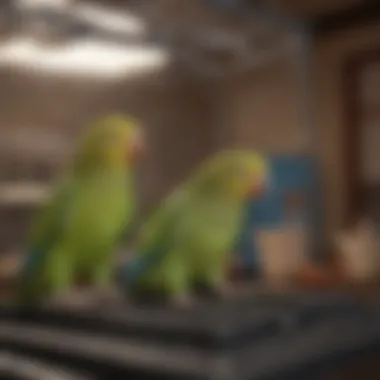
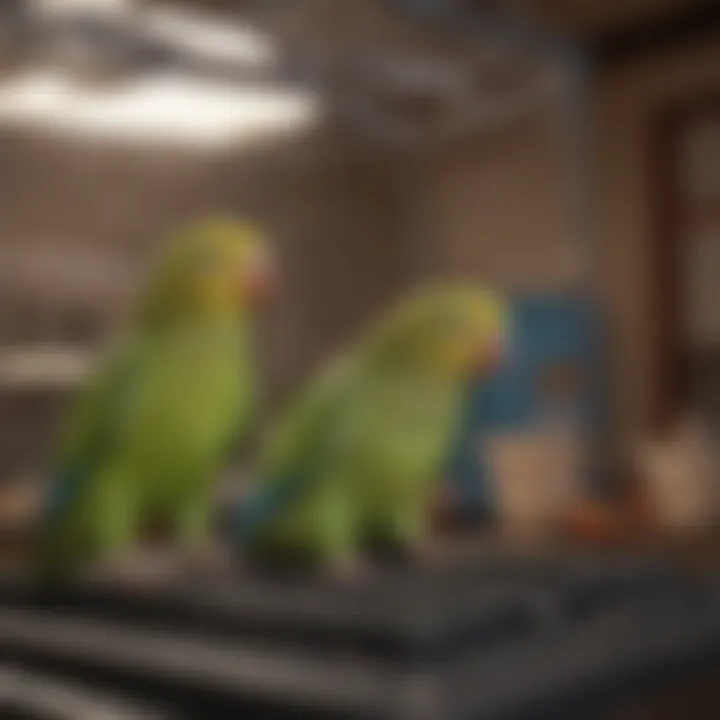
Outdoor flight cages serve a dual purpose. They provide the birds with large, unrestricted areas to fly, while allowing exposure to natural sunlight and fresh air. This type of cage encourages physical activity and mimics the natural behavior of parakeets. Outdoor setups can often be larger, as the space can accommodate several birds, providing social interaction in a safe environment.
When selecting an outdoor cage, material considerations become crucial. Choosing weatherproof and durable materials enhances safety and longevity. Regular maintenance checks have higher importance when the cage is outside. Monitor it closely for wear and issues such as rusting or degradation from the elements. Predators are also a concern, as outdoor environments may expose birds to natural threats. Having sturdy perimeter designs helps maintain security against unwanted visitors.
Multi-Level Flight Cages
Multi-level flight cages offer vertical space optimization, which promotes a sprawling environment for parakeets. These structures have multiple shelves or levels allowing birds to explore in an upward and downward fashion. Height becomes particularly beneficial where floor space is limited, and it encourages natural climbing behaviors without sacrificing their ability to fly.
Owners can personalize multi-level cages with diverse setups such as ladders, different perch placements, and varied materials for mental engagement. Birds consistently explore environments stimulated with variations that taper their interests and keep them active. Assembling these cages properly requires careful planning to avoid hazardous areas, making bird care essential for optimal use. Attention to design and vertical arrangements is crucial, as it reflects directly on your birds’ enjoyment.
In summary, when selecting the type of flight cage suitable for your parakeets, consider various locations and sizes. Each type has distinct advantages that cater to the environmental conditions and interactive requirements of the birds. Focus on structural integrity, safety, and ample play areas to ensure your parakeets thrive.
"Birds are not just a hobby; they reflect dedication to enhanced living environments that support their needs ultimately."
In your decision-making process for the best flight cage form your parakeets, prioritize their specific needs and environmental comforts while engaging and enriching their lives.
Key Features to Consider in a Flight Cage
When selecting a flight cage for parakeets, understanding the key features is essential. These features shape the living environment of your birds and influence their overall well-being. An ideal cage not only meets the needs of parakeets but also enhances their quality of life.
Size and Dimensions
The first factor to address is the size and dimensions of the flight cage. Parakeets are active by nature. They thrive in spacious environments that allow for movement, stretching their wings, and exercising. Often, smaller cages restrict their ability to fly and engage in natural behaviors.
The recommended size for a flight cage is at least 24 inches long, 18 inches wide, and 18 inches high for a single parakeet. More than one bird? Increase the dimensions accordingly. A multiple-level cage can also offer additional space, though horizontally expanding is generally preferred. Ensuring ample space is vital for keeping parakeets healthy and happy.
Bar Spacing and Material
Next, consider bar spacing and material when choosing a cage for your parakeets. Bars that are too far apart may risk birds escaping or potential predators getting inside. Aim for a spacing of about 1/2 inch or less.
Materials, too, need special consideration. Cages made from stainless steel are durable and easy to clean, reducing the risks of toxins affecting your birds. Avoid cages with painted finishes unless specified as safe, since some paints contain harmful chemicals. Premium materials assure safety while enhancing longevity.
Accessibility and Portability
Finally, think about accessibility and portability. Cages with more entrances and easy access points allow bird owners to feed, clean, and interact with pets conveniently. A removable bottom tray can also significantly simplify cleaning processes, contributing to a healthy living environment for the birds.
Portability is another important aspect. If you plan to move the cage or take it outdoors, the presence of wheels or lightweight materials will be incredibly advantageous. Portable options also promote versatility when arranging living spaces, accommodating different home setups.
Providing your parakeets with a spacious, safe, and accessible flight cage aids their physical and emotional well-being.
Setting Up the Flight Cage
Setting up a flight cage is a significant step in ensuring the well-being of your parakeet. This task requires thoughtful consideration of various elements to create a nurturing environment. A well-configured flight cage not only contributes to the bird's happiness but also promotes healthy behaviors. Careful attention to accessories, safety, and enrichment will enhance your bird's quality of life.
Selecting Appropriate Accessories
The accessories chosen for a flight cage can have a major impact on the parakeet's comfort and activity levels. Selecting appropriate items is crucial for both physical and mental stimulation. Essential accessories include:
- Perches: Providing various types of perches can help prevent foot problems. Options range from natural hardwood like manzanita to softer options. Integrated heights enhance movement and climbing.
- Food and Water Dishes: These should be easily accessible and clean. Stable dishes prevent spills, while water should be filtered to avoid contamination.
- Toys: Engage your parakeet's natural curiosity with toys. Rotating and varying them can keep your bird entertained. Include climbing structures and chewables that account for natural behaviors.
- Nest Boxes or Hideaways: Incorporating small, safe spaces gives your bird the comfort to retreat. It also allows for moments of retreat when seeking lull or privacy.
In summary, employing an appropriate mix of accessories tailored to your bird's behaviors aids in creating a captivating living environment.
Creating a Safe Environment
Safety must be a primary consideration when setting up a flight cage. A secure environment can prevent accidents and reduce stress for the parakeet. Here are key aspects to concentrate on:
- Material Choice: Use non-toxic materials for all accessories and cage components to guard your parakeet’s health. Stainless steel food and water dishes resist corrosion and are easy to clean.
- No Sharp Edges: Ensuring that the cage has no sharp edges avoids accidental injuries. Any potential hazards should be eliminated to maintain a risk-free space.
- Balanced Design: A symmetrical structure aids parakeets in terms of navigating the space effortlessly. Avoid clutter and maintain organized structure within the cage.
- Proper Monitor: Upon first introducing the cage to your home, diligent observation of your parakeet is essential. Getting accustomed might take time; eliminating stress factors is important.
Creating a sanctuary that prioritizes safety boosts your parakeet's health and peace of mind.
Incorporating Enrichment Elements
Adding enriching elements to a flight cage is fundamental to stimulate mental engagement and supportive living conditions. Enrichment enhances interactions, encouraging more exercise within the flight area. Here are strategies to consider:
- Visual and Auditory Enrichments: Natural items like branches can simulate outdoor habitats. Additionally, background sounds can introduce new sensory experiences, making the environment immersive.
- Social Interaction: Parakeets are social creatures. If possible, offering companionship by introducing another budgie can enhance quality of life. Just be cognizant of possible territorial instincts.
- Time Outside: Designate time outside of the cage, where the bird can safely explore a supervised area is vital. It also provides tactile experiences that can promote well-rounded behavior.
- Interactive Toys: Rotate toys that challenge your parakeet's problem-solving skills. Puzzle feeders and foraging toys promote natural instincts and stave off boredom.
Utilizing these enrichment ideas can lead to a higher psychological well-being and activity levels in your parakeet.
A well-set-up flight cage paired with enriching elements offers a holistic approach to raising content parakeets.
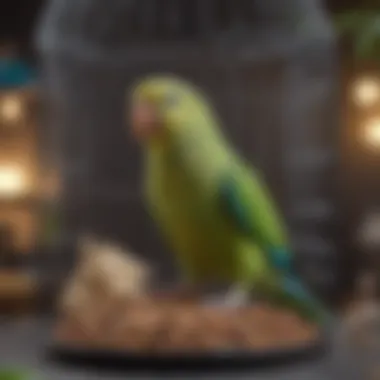
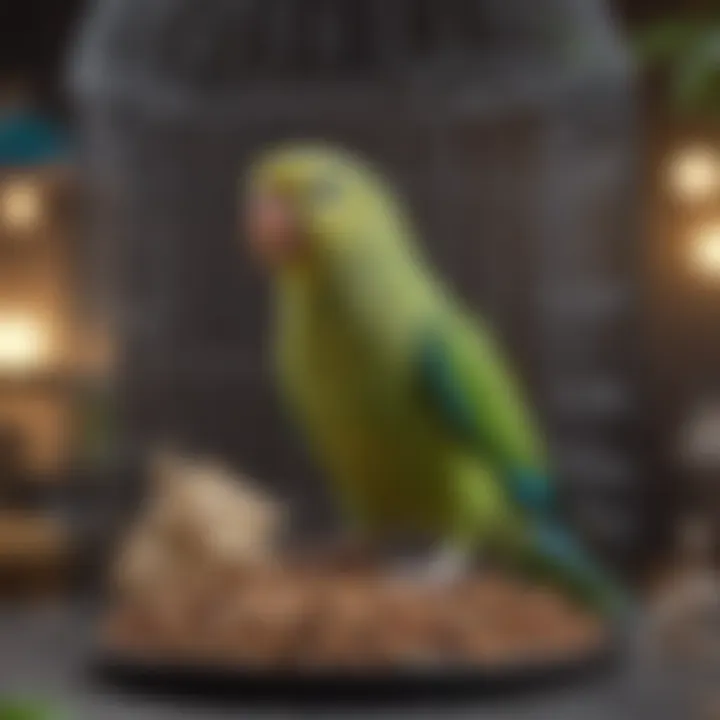
Maintenance and Care of Flight Cages
Proper maintenance and care of flight cages are crucial for ensuring the long-term health and happiness of parakeets. Flight cages not only serve as a living space but also play a role in stimulating your parakeet's natural behaviors. Neglecting maintenance could lead to serious health issues or unwanted behaviors in birds. Therefore, a consistent cleaning schedule and regular inspections become key factors for any dedicated bird owner.
Cleaning Protocols
Establishing effective cleaning protocols is essential for the well-being of your parakeet. A clean environment helps to prevent the buildup of bacteria and pests that can harm your bird. Here are some steps to follow:
- Daily Cleaning: Inspect the cage each day. Remove uneaten food, and discard waste that has accumulated on the bottom tray. This simple practice can greatly reduce odor and the spread of disease.
- Weekly Cleaning: Once a week, perform a more thorough cleaning. Take out all accessories, perches, and food containers. Wash these items with unscented, mild soap and rinse them well to prevent any residue that might harm your pet. Clean the bars and the bottom of the cage with a mixture of vinegar and water for antibacterial properties.
- Monthly Deep Clean: Every month, consider a more extensive cleaning. Soak movable parts in a solution of warm water and vinegar to eliminate any stubborn stains or buildup. Make sure to rinse all items thoroughly before replacing them in the cage.
It's also essential to ensure that anything placed in their environment is non-toxic. Always verify if cleaning products are safe for birds.
Regular Maintenance Checks
Regular maintenance checks serve as an important preventive measure. By making time to observe and evaluate all elements of the flight cage, you can immediately spot any problematic areas that require attention.
- Inspect for Damage: Examine bars and accessories for wear and tear or signs of damage. Broken surfaces can harm birds, transcending a simple issue into a life-threatening concern. If infected areas are noted, they must be repaired or replaced promptly.
- Assess Functionality: After performing your weekly and monthly cleans, ensure that all accessories are functioning well. Perches should be stable, food dispensers must function without impediments, and cleanliness of water containers should always be maintained.
- Modify as Needed: If you observe unusual behavior in your parakeet, it may be time to rethink the arrangement within the flight cage. Sometimes a minor adjustment can lead to happier birds.
Regular maintenance not only prolongs the life of the cage but also contributes to the comfort and enrichment of your parakeet's environment.
“A clean environment and proper upkeep simplify care while promoting your bird’s quality of life.”
Common Mistakes with Flight Cages
Understanding the common mistakes made in relation to flight cages is crucial for any avian enthusiast. It directly affects the welfare and happiness of parakeets. By recognizing and addressing these errors, bird owners can create a more enjoyable and satisfying environment for their feathered companions. Here are two significant mistakes that often occur.
Underestimating Space Requirements
Space is one of the most fundamental elements when considering the well-being of parakeets. Many individuals tend to choose cages that are either too small or insufficiently accommodating. Parakeets are naturally active creatures and require space to stretch their wings and move around freely. A cramped cage can lead to behavioral issues and physical health problems.
- When selecting a flight cage, consider the following:
- Minimum Dimensions: For a pair of parakeets, aim for a cage that is at least 24 inches long, 18 inches wide, and 24 inches high.
- Flight Space: If possible, opt for a larger model that provides ample room for flyin complex movements.
- Non-obstructed Walls: Cages with more vertical space rather than merely extensive width can significantly help in behaviors like climbing and fluttering.
Using the proper cage size does not simply facilitate movement, but also contributes to emotional stability and overall happiness. Choosing appropriate space helps to create an enriching atmosphere that is vital for your pet's lifelong well-being.
Neglecting Social Needs
Parakeets are inherently social birds that thrive on interaction. Neglecting to consider their regal social behavior can lead to significant issues, both mentally and emotionally. When birds don’t receive attention or are isolated for long periods, they can develop a variety of problems, including stress or even feather plucking.
It is essential to keep the following in mind:
- Companionship: If you are unable to dedicate enough time, consider getting a second parakeet. They find great joy in having a buddy.
- Daily Interaction: Regardless of whether there is another bird companion or not, engaging regularly with your parakeets is vital. This interaction can be talking, playing, or training.
- Observing Time: Watch for behavioral signs that suggest your bird may feel lonely or bored. Repetitive pacing, loud calls, or diminished activity can all indicate a need for companionship.
When their social needs are met, parakeets not only flourish but also display happier, more active behaviors. It is essential to create an environment that encourages socialization, whether it be with other birds or through regular interactions with their owner.
Being attentive to both space and social requirements can dramatically improve the overall quality of life for parakeets.
These common mistakes reveal deeper insights about the responsibilities of maintaining parakeets in captivity. Improved awareness can significantly enhance both the owner’s and the bird’s experience. Technical or whimsical considerations can sometimes cloud critical aspects, but focusing clear on the essentials is vital in fostering an enriching environment for these vibrant creatures.
Closure and Future Considerations
As this exploration of parakeet flight cages come to an end, it is clear that having the right setup significantly enhances the quality of life for these birds. The overall well-being and happiness of parakeets are directly linked to the effectiveness of their environment, and a suitable flight cage serves as more than just a home. For bird owners, recognizing the importance of this journey enriches not only their pet's life but also their bond with the bird.
The Impact of a Proper Flight Cage
The right flight cage not only meets the physical needs of a parakeet but also plays a pivotal role in their behavioral health. A spacious and thoughtfully designed cage can help reduce stress and provide a sanctuary for these intelligent creatures. Spending time in a well-structured cage allows birds to engage in their natural behaviors, such as flying, climbing, and socialization, elements crucial for their happiness. Additionally, a good cage setup minimizes health risks, promoting physical activity and reducing the chance of obesity-related diseases.
Some key benefits impact both the parakeet and the owner:
- Improved Mental Health: A spacious environment reduces boredom and promotes exploration, benefiting their mental state.
- Physical Health: Encouraging parakeets to move around freely supports their muscle tone and overall health.
- Social Interaction: A properly set up cage fosters interaction with owners, strengthening the bond between pets and their caregivers.
"An Even Better cage means a better quality of life anchored by physical and emotional health."
Knowing these ramifications prompts care considerations. Birds deserve environments reflective of their needs and character.
Evolving Standards in Bird Care
Over the years, perspectives on bird care have evolved significantly. The understanding that parakeets thrive in enriched environments continues to gain momentum among pet owners and breeders. As communities push toward better standards, owners must recognize what these changes mean for their feathered companions. Modern aviary practices emphasize the necessity for larger and more dynamic living spaces compared to cages of past times.
Looking ahead, several core developments shape the future of bird care:
- Increased Advocacy: Organizations and forums such as reddit.com, demonstrate ongoing discussions on optimal bird care practices, pushing for more advocacy and awareness.
- Improved Designs: Flight cages are increasingly being crafted from safer materials with advanced designs that reflect birds’ behavior.
- Community Education: Platforms are focusing on informing bird owners through resources such as en.wikipedia.org and britannica.com, helping them recognize the changing standards.
Adjusting to these evolving standards encourages owners to reconsider and advocate for practices that align with the most recent knowledge about parakeet care. The birds are not merely pets; they are companions that depend on us to create the best possible surroundings. Investing in their well-being through adequate flight cages solidifies the promise we make to cherish and support their lives.















